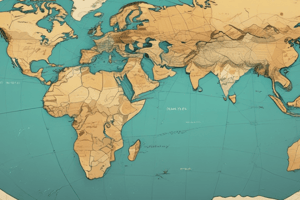Podcast
Questions and Answers
Match the type of migration with its definition:
Match the type of migration with its definition:
Voluntary Migration = Movement of individuals or groups who choose to relocate for better economic opportunities, education, or personal reasons. Forced Migration = Movement of individuals or groups who are forced to flee due to conflict, persecution, natural disasters, or other life-threatening circumstances.
Match the push factor with its definition:
Match the push factor with its definition:
Poverty = Attractive conditions in the destination country, such as better job opportunities. Natural disasters = Conditions in the country of origin that drive people to migrate. Unemployment = Conditions in the country of origin that drive people to migrate. Family reunification = Attractive conditions in the destination country, such as better job opportunities.
Match the cause of human migration with its definition:
Match the cause of human migration with its definition:
Economic Factors = Differences in income, employment, and economic opportunities between countries. Demographic Factors = Natural disasters, climate change, and degradation of natural resources. Environmental Factors = Age, population growth, and urbanization in the country of origin. Political Factors = Differences in income, employment, and economic opportunities between countries.
Match the pull factor with its definition:
Match the pull factor with its definition:
Match the type of factor with its definition:
Match the type of factor with its definition:
Match the migration theories with their descriptions:
Match the migration theories with their descriptions:
Match the effects of human migration with their descriptions:
Match the effects of human migration with their descriptions:
Match the effects of human migration with their descriptions:
Match the effects of human migration with their descriptions:
Match the migration theories with their focuses:
Match the migration theories with their focuses:
Match the effects of human migration with their descriptions:
Match the effects of human migration with their descriptions:
Flashcards are hidden until you start studying
Study Notes
Types of Human Migration
- Voluntary Migration: Movement of individuals or groups who choose to relocate for better economic opportunities, education, or personal reasons.
- Forced Migration: Movement of individuals or groups who are forced to flee due to conflict, persecution, natural disasters, or other life-threatening circumstances.
Push and Pull Factors
- Push Factors: Conditions in the country of origin that drive people to migrate, such as:
- Poverty
- Unemployment
- Political instability
- Conflict
- Natural disasters
- Pull Factors: Attractive conditions in the destination country, such as:
- Better job opportunities
- Higher standard of living
- Access to education and healthcare
- Family reunification
- Political stability
Causes of Human Migration
- Economic Factors: Differences in income, employment, and economic opportunities between countries.
- Demographic Factors: Age, population growth, and urbanization in the country of origin.
- Environmental Factors: Natural disasters, climate change, and degradation of natural resources.
- Political Factors: Conflict, persecution, and political instability in the country of origin.
- Social Factors: Family reunification, education, and social networks.
Effects of Human Migration
- Economic Effects:
- Brain drain in the country of origin
- Remittances sent back to the country of origin
- Contribution to the economy of the destination country
- Social Effects:
- Cultural diversity and exchange
- Integration and assimilation challenges
- Changes in population demographics
- Environmental Effects:
- Urbanization and strain on resources
- Impact on biodiversity and ecosystem services
Migration Theories
- Neoclassical Economics Theory: Migration is driven by individual economic decisions based on cost-benefit analysis.
- New Economics of Labor Migration Theory: Migration is driven by household decisions to maximize income and minimize risk.
- Social Network Theory: Migration is driven by social networks and relationships between individuals.
- World Systems Theory: Migration is driven by global economic structures and inequality.
Studying That Suits You
Use AI to generate personalized quizzes and flashcards to suit your learning preferences.




